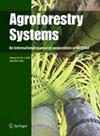摘要
遮荫咖啡种植园保持着食俭蝙蝠物种的高度多样性,其功能特征各不相同。然而,关于植被结构的变化如何影响这种多样性和功能特征的证据却很有限。我们评估了植被复杂性对墨西哥南部三种土地利用类型--废弃的荫生咖啡种植园、活跃的荫生咖啡种植园和牛牧场--食俭蝙蝠群落(以及两个功能群:底层和冠层蝙蝠觅食者)的丰富度、多样性、丰度和功能特征的影响。在每种土地利用类型的四个地点,我们都进行了植被以及底层和冠层觅食俭食蝙蝠的调查。我们捕获了 680 只食俭蝙蝠,隶属于 Phyllostomidae 科的 12 个物种;其中 76% 为林下觅食蝙蝠,24% 为树冠觅食蝙蝠。与牛群牧场相比,废弃的咖啡种植园和活跃的咖啡种植园植被复杂度最高,食俭蝙蝠的丰富度、多样性和丰度也更高。我们还发现,两种咖啡种植园类型的底层和冠层俭食蝙蝠的组成和丰度存在差异,这可能是由植物组成和植被结构的差异造成的。随着植被复杂程度的降低,俭食蝙蝠的功能特征,如翅膀负荷和体重,通常会增加,而冠层俭食蝙蝠的长宽比则与此相反,与两种咖啡种植园相比,牛牧场中的长宽比更低。这项研究强调了当前和废弃的遮荫咖啡种植园在保护俭食蝙蝠方面的重要性,因为它们有能力维持丰富的物种和具有不同功能特征的蝙蝠群落。Shade coffee plantations maintain a high diversity of frugivorous bat species with varied functional traits. However, there is limited evidence on how this diversity and functional traits are influenced by variations in vegetation structure. We evaluated the effect of vegetation complexity on the richness, diversity, abundance, and functional traits of frugivorous bat communities (and two functional groups: understory and canopy bat foragers) across three land use types—abandoned shade coffee plantations, active shade coffee plantations, and cattle pastures—in southern Mexico. In four sites for each-land use type, we conducted vegetation and understory- and canopy-foraging frugivorous bats surveys. We captured 680 frugivorous bats belonging to 12 species of the Phyllostomidae family; 76% were understory foragers, and 24% were canopy foragers. Abandoned and active coffee plantations exhibited the highest vegetation complexity and showed higher frugivorous bat richness, diversity, and abundance compared to cattle pastures. We also found differences in the composition and abundance of understory and canopy frugivorous bats between the two coffee plantation types, likely driven by differences in plant composition and vegetation structure. Functional traits of frugivorous bats, such as wing loading and body mass, were generally greater as vegetation complexity decreased, the opposite was found for aspect ratio in canopy frugivores, which were lower in cattle pastures compared to both coffee plantations. This study highlights the importance of current and abandoned shade coffee plantations in frugivorous bat conservation due to their capacity to sustain high species richness and bat communities with varying functional traits.

 求助内容:
求助内容: 应助结果提醒方式:
应助结果提醒方式:


